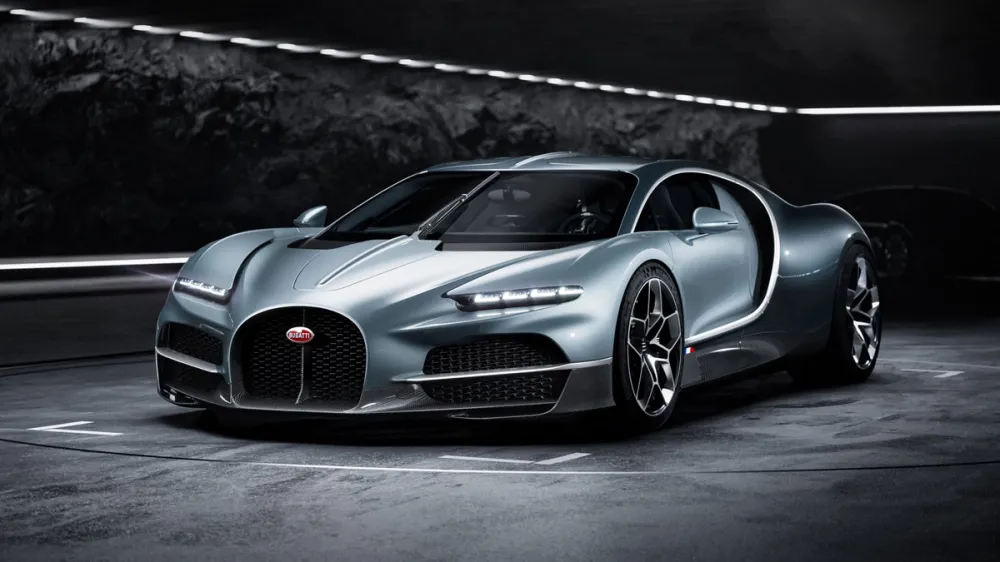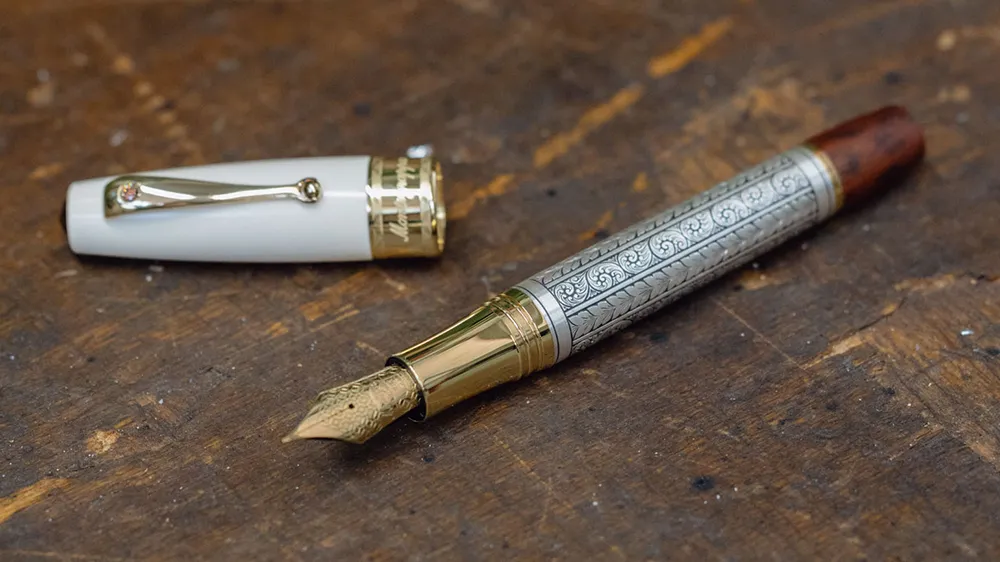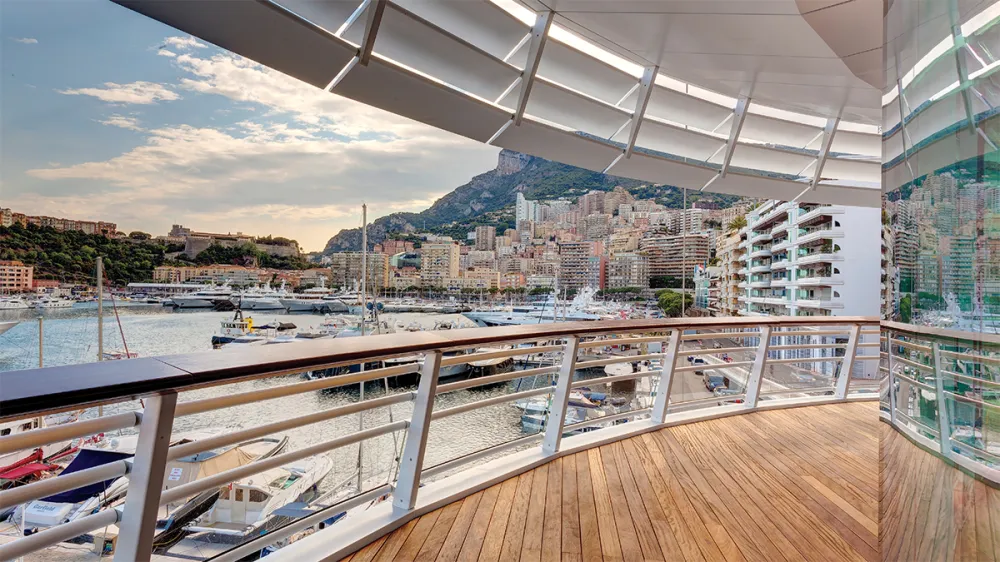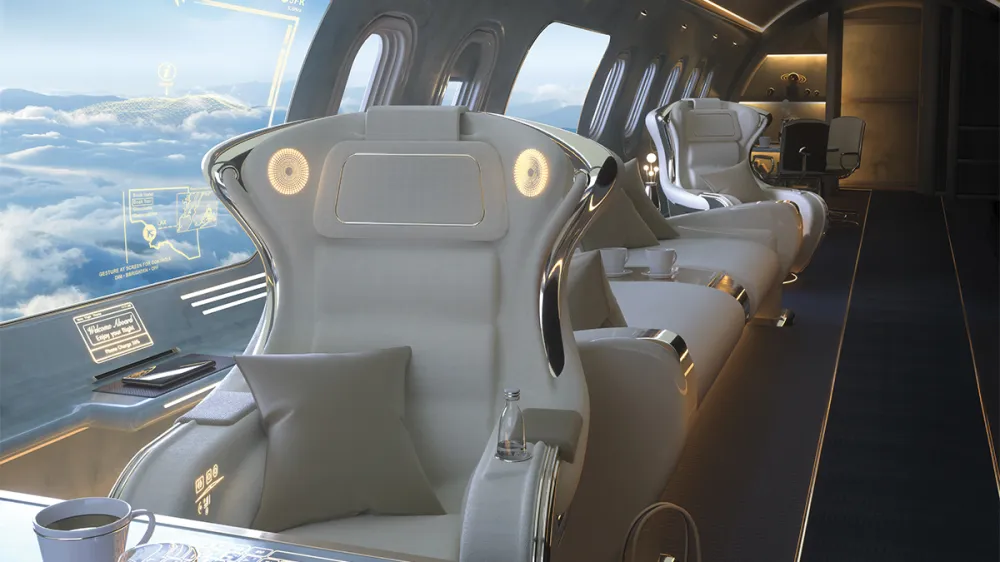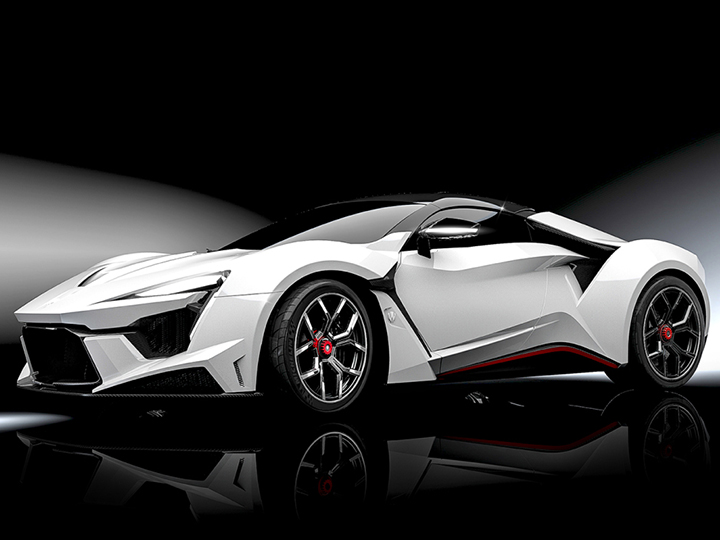
Six stunning supercars that fly under the radar
A growing number of boutique builders are accelerating out of the shadows and presenting boundary-breaking design, engineering, and performance.
Related articles
Marques such as McLaren, Lamborghini, and Bugatti are synonymous with supercars, and rightly so. These icons of innovation repeatedly set new benchmarks in all areas of the industry, and continue to fine-tune the template of exclusivity for others to follow — and follow they are.
A growing number of boutique builders are accelerating out of the shadows and creating their own automotive machinations — each presenting boundary-breaking design, engineering, and performance. The examples here, rolling in the seven-figure price range, may lack name recognition, but they will certainly give their market segment some souped-up competition.
## Boreas

Named for the mythological Greek god of the north wind, the Boreas — from Spain’s DSD Design & Motorsport — is two-door tempest touting a mostly carbon-fibre monocoque construction and a proprietary hybrid power train that generates more than 745 kW. The latter, which also includes a 7-speed automated manual transmission, allows the brute to blow from zero to 100 km/h in 2.8 seconds and reach a top speed of 380 km/h.
“The Boreas project arose from the ambition to strive for technical and aesthetic innovation,” says DSD founder David Sancho Domingo. “We were also focused on the search for ergonomics within the varying physical and psychological scales that would be experienced.”
Prior to beginning Boreas, Domingo educated himself on the intricacies of supercar construction by journeying throughout Europe and the United States to personally meet with marques that specialise in high-performance vehicles — such as Pagani and Shelby, among others — and tour their facilities. The fact-finding foray helped him decipher the direction he and his team would take in the hope of making an indelible impression on the industry.
After 10 years in development, a standing model of Domingo’s own automotive dynamo was introduced at France’s 24 Hours of Le Mans endurance race last June, followed by a completed prototype shortly thereafter. And while the Boreas is a one-off, 12 individually designed successors are planned for production in January.
## ZeroUno

‘It wasn’t an architect or a designer that invented objects, but an artisan.”
— Giorgetto Giugiaro
Although founder Giorgetto Giugiaro — named Car Designer of the Century in 1999 — is no longer with the firm, Italdesign has not only kept its purpose-driven passion, but increased the intensity. Acclaimed for the automotive artistry it has produced for others in the industry, the Torino-based team has finally stepped in front of the creative curtain to reveal its own masterwork — the ZeroUno supercar.
“The only way to design a successful sports car is to use the form-follows-function approach,” says Filippo Perini, head of design for Italdesign and the man responsible for the look of the Lamborghini Aventador. “For the ZeroUno project, we communicated a design language that fits with our company’s DNA, and we employed a simultaneous engineering process.”
Badged under the nearly 50-year-old firm’s new brand, Italdesign Automobili Speciali, the arrow-like automobile was presented in full force to the United States market at the 2017 Pebble Beach Concours d’Elegance on August 20. It was soon clear from its premiere that the car would be a crowd-pleaser in California.
And it’s no surprise, as the four-wheel-drive coupe’s appearance is as compelling as its performance. Built from a chassis constructed of carbon fibre and aluminum, and covered in a completely carbon-fibre body, the car carries a 455 kW, 5.2-litre naturally aspirated V10 engine (with 560 Nm) mated with a paddle-shift-activated dual-clutch 7-speed gearbox.
The power train enables the ZeroUno to zip from stationary to 100 km/h in 3.2 seconds and zoom up to 330 km/h. The car’s efficiency in motion is enhanced by an air-slicing aesthetic. “The ZeroUno has more in common with Italian GTs of the 1960’s,” explains Perini. “It’s a mix of soft, clean surfaces for the main body and extremely functional aerodynamic elements.”
The ZeroUno rolls with a starting price of US$1.7 ($A2.1) million. And seeing how well it fits in with the Golden State’s penchant for power and panache, one can only wonder if a sibling convertible is inevitable.
## Fenyr SuperSport

Based in the United Arab Emirates, W Motors introduced the Fenyr SuperSport to the world in 2015 at the Dubai International Motors Show. Named after a mythological wolf, the carbon-fibre ferocity, with a tubular aluminum chassis, has fangs in the form of a 4-litre twin-turbo flat-6 engine (built by Germany’s RUF Automobile) that nets 670 kW and 1,200 Nm. And with a 7-speed, double-clutch gearbox as part of the power train, the car clocks zero to 100 km/h in 2.7 seconds and can cruise at up to 400 km/h. With only 25 examples planned per year, each one will be priced at approximately US$1.85 ($A2.36) million.
## Lykan HyperSport

Another leader of the supercar pack is the Lykan HyperSport, also by W Motors. Debuted at the Qatar Motor Show in 2013, the ground-breaking coupe features diamond-encrusted headlights, reverse-dihedral doors, holographic instrumentation, and gold-stitched seats. Referencing the Greek word for “werewolf,” the Lykan lunges from zero to 100 km/h in 2.8 seconds and can give chase at up to 386 km/h thanks to its 580 kW, 3.7-litre flat-6 engine (producing 960 Nm). These performance characteristics, along with a distinct body design and a price tag of US$3.4 ($A4.3) million, earned it a starring role in the 2015 film Furious 7. Coincidentally, only seven bespoke examples are planned for production.
## Fittipaldi EF7 Vision Gran Turismo

With a pedigree that comprises three pillars of the motorsports industry, the Fittipaldi EF7 Vision Gran Turismo by Pininfarina can’t help but be a top contender on the track. Presented at the 2017 Qatar Motor Show (April 18 through 22), the car is the collaborative creation of Brazil’s famed wheelman Emerson Fittipaldi, Italy’s premier coachbuilder Pininfarina, and Germany’s elite engineering team at HWA AG — a winning recipe for racing.
The composite coupe relies on carbon-fibre monocoque construction and carries a naturally aspirated V8 engine mated with an integrated gearbox. The power train, suspension, and braking system have been developed by HWA AG but are housed in a body that is distinctly Pininfarina in design. With its shark-like aesthetic, the automobile presents the same visual cues as its aquatic counterpart — an intimidating form that is strikingly streamline. But that is to be expected since the car’s eponymous racer was an apex predator in competition.
Fittipaldi was a dominant force during the decade of his Formula 1 career and won his first F1 Drivers’ Championship in 1972 at the age of 25, the youngest, at the time, to do so. And he is also the only driver to win the Indianapolis 500 and F1 Championship on multiple occasions, reason enough for his induction into the Motorsports Hall of Fame of America in 2001.
Upon purchase of a limited-edition example, aspiring racers will also be buying themselves a personal coaching session with the legend and eligibility for membership in the Fittipaldi Racing Club, host of global driving events. But those who steer toward more vicarious forms of vehicular contest will soon have their chance behind the wheel as well. A virtual version of the car will star in the latest release of Polyphony Digital’s popular Gran Tursimo game series and its interactive FIA Gran Turismo Championships.
## Pagani Huayra BC

Introduced at the Geneva International Motor Show in 2016 as a US$2.5 ($A3.1) million variant to Pagani’s original Huarya coupe, the BC (named in honour of Horacio Pagani’s close friend Benny Caiola) features the Italian marque’s carbon-titanium monocoque construction for the chassis and an enhanced 560 kW, twin-turbo Mercedes-Benz AMG V12 engine that turns out more than 560 kW and is exclusive to Pagani. Mated to that muscle is a bespoke 7-speed automated manual transmission (AMT) that features Xtrac’s new electro-hydraulic actuation for faster and more precise shifting. Other innovations on board include Bosch’s antilock braking system, traction control, and electronic stability program.
Subscribe to the Newsletter
Recommended for you
Time Flies
Bugatti’s hybrid Tourbillon is the most powerful model in the marque’s history. And the coolest bit? An instrument cluster inspired by the finest Swiss horology.
Why the Alfa Romeo Giulia Sprint GT Is the Quintessential Italian Sports Car
Built from 1963 through 1977, the feisty yet refined model—comprising several variants—delivers a timeless driving experience.
By Robert Ross
October 17, 2024
You may also like.
You may also like.
This Italian Company Made Ernest Hemingway’s Favourite Pens. Here’s How It’s Done.
At Montegrappa, a focus on age-old techniques makes for unique, heirloom-quality fountain pens.
In this age of digital supremacy, it’s reassuring to know the pen is alive and well. And nowhere is it thriving quite like it is in Bassano del Grappa, a picturesque medieval village in Veneto, Italy, that has been home to Montegrappa, the country’s oldest pen company, since 1912. The firm specialises in rollerball and fountain pens for the discerning, and its products are still made in its original factory on the banks of the Brenta River.
Notable actors, athletes, musicians and even popes have used its wares, but the seed for one of Montegrappa’s most significant endorsements came when a then-unpublished author encountered the brand in 1918. Ernest Hemingway, just 19 years old at the time, was serving as a volunteer ambulance driver for the American Red Cross when he was assigned to a station 100 m from the factory. The robust Elmo model, still produced by Montegrappa today, became his writing instrument of choice.
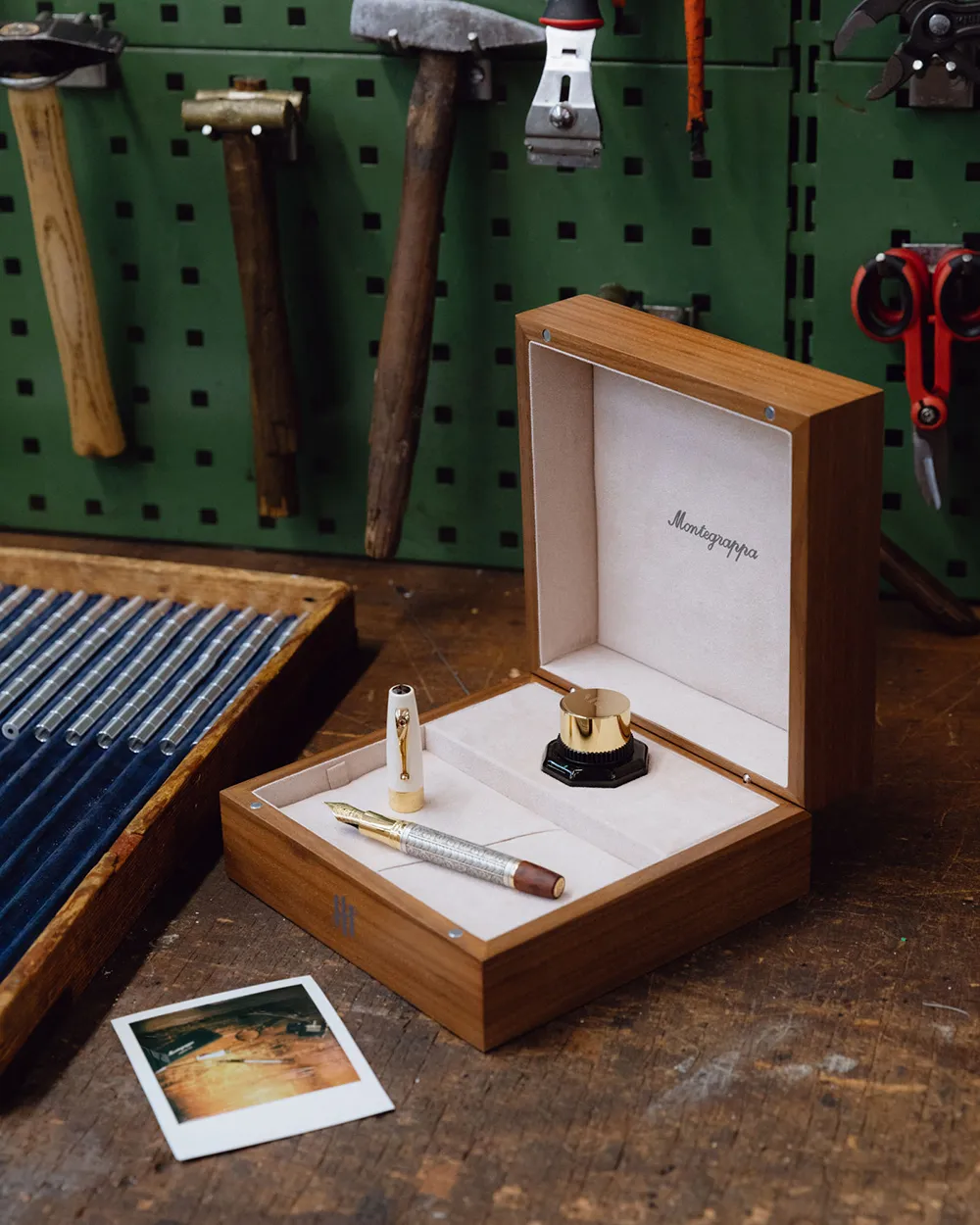
More than a century later, Montegrappa pens remain renowned for their design and are still largely crafted by hand according to the company’s old-world manufacturing process. And while you can order a model off the shelf, varying levels of customisation are also available. Through the Extra Custom program, you can commission a uniquely hand-painted or burin-engraved style made from sterling silver or yellow, rose, or white gold and have the barrel decorated with an image or motif you select. Such pieces can require several weeks to complete, and prices range from around $2,400 to as high as $67,000—all to create a pen that’s a story in itself.

Each pen requires at least 36 individually handcrafted components—some considerable, others tiny and delicate.
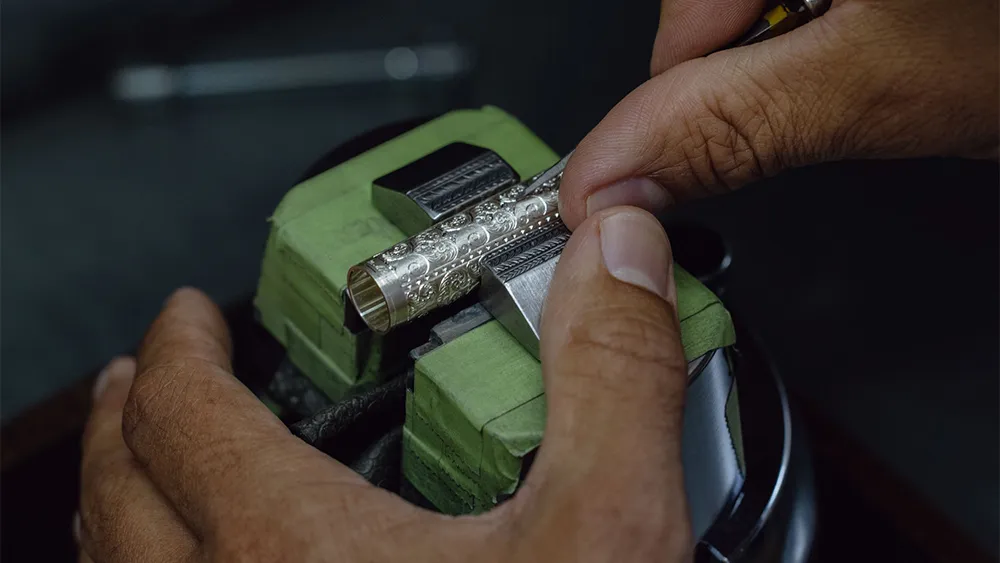
As perhaps the most visible component, the pen clip is hand-polished to a mirror-like shine. You can opt to have it set with a small cubic zirconia, as with this sterling-silver example.

Mammoth ivory, ethically recovered from Siberian permafrost, is carefully machine-turned to create the cap. The company also offers celluloid for its caps and barrels, as well as exotic woods, marble, carbon fibre, various metal alloys and a house-made resin called Montegrappite.

The cap band is machine-engraved with the company logo. The process also allows for the back of the band to be similarly etched with your initials in a selection of three fonts.
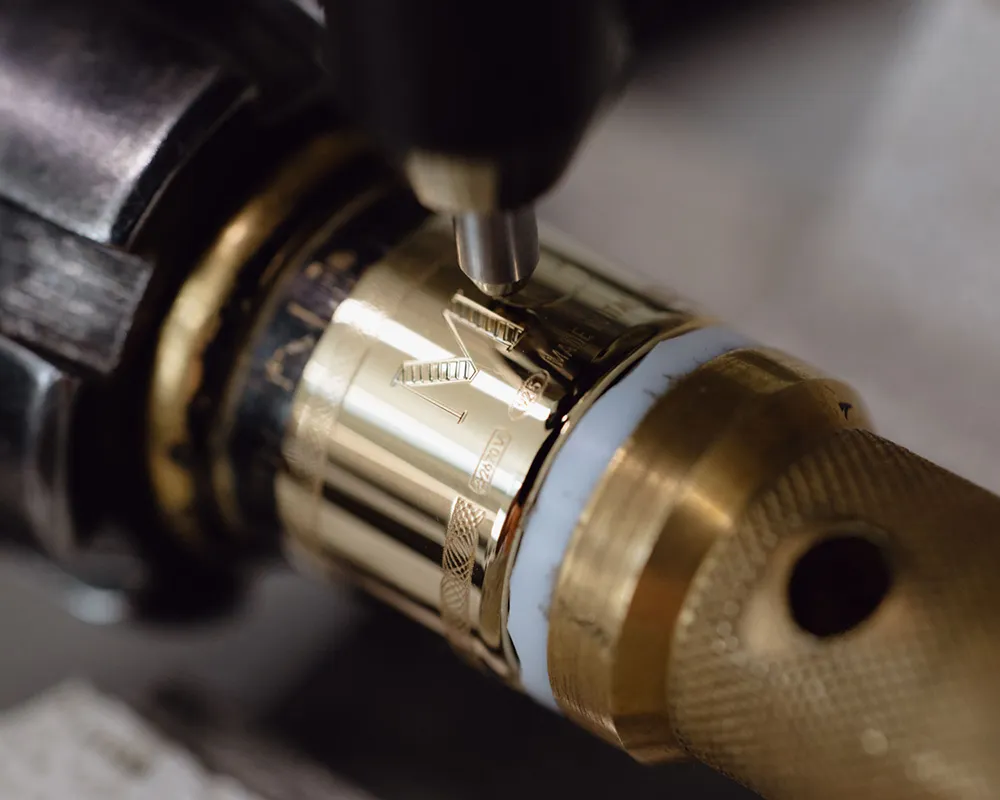
A burin is used to inscribe a “leaves and scrolls” pattern on the pen’s barrel. The intricate technique can also be used to reproduce photographs or works of art.
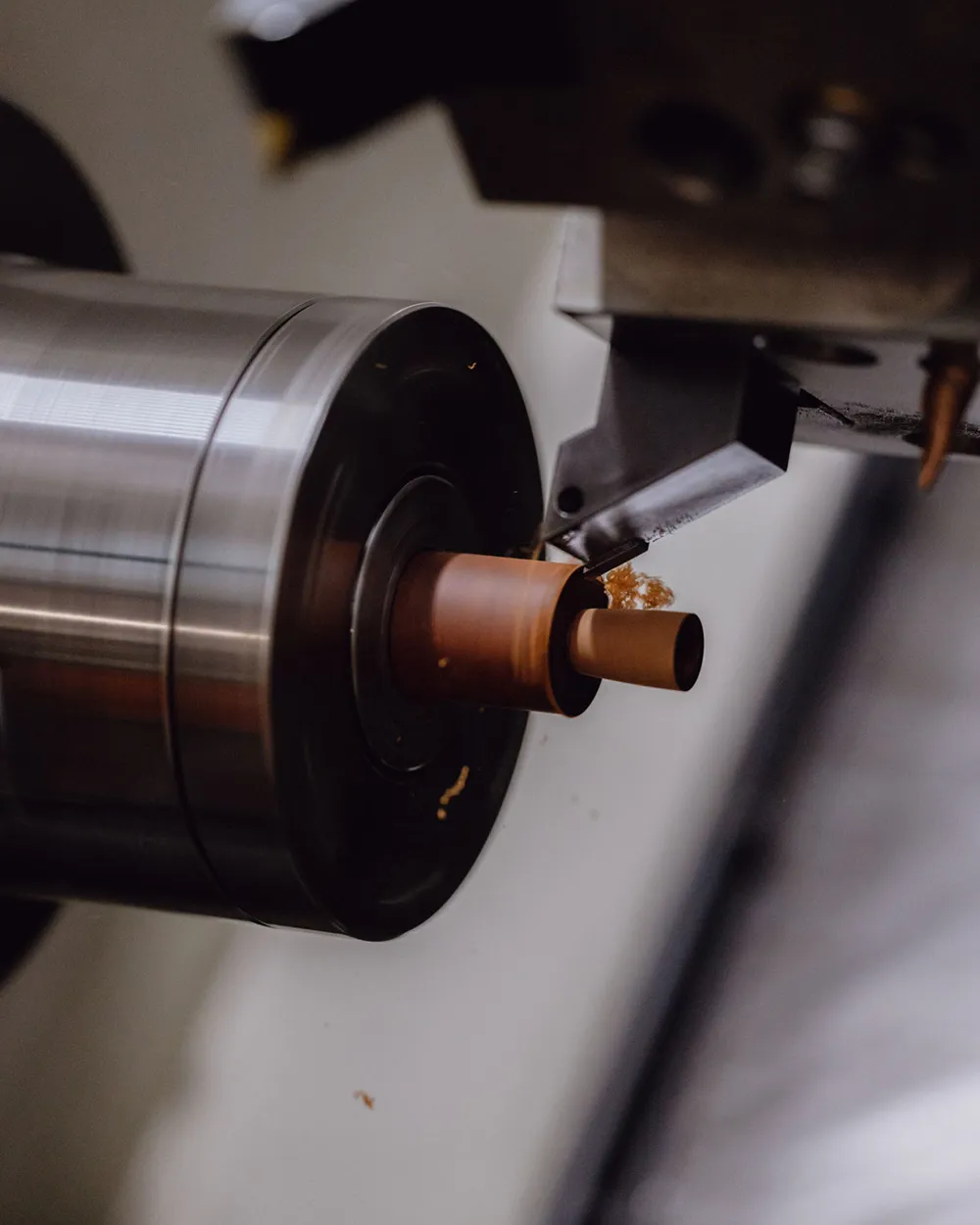
Montegrappa uses ebonite, a vulcanised rubber, to make its feeds, which connect a pen’s nib to its reservoir. The material is more porous than hard plastic, allowing for better ink flow. A craftsman precisely cuts the feed’s fins to ensure the best performance.
You may also like.
From Striped Hawaiian Shirts to Colorful Ceramics: 4 Luxe Items You Can Buy at Italian Hotels
A handful of Italy’s most beloved family-owned hotels are morphing into luxury brands of their own. Here, four in-house items worth traveling for.
Hotel Passalacqua, Lake Como

These days, it takes more than the finest linens and a Michelin-starred restaurant to take the No. 1 spot on a list of the world’s 50 best hotels, which Hotel Passalacqua did in 2023. The spa is stellar, to be sure, as is the pool house, which was decorated in collaboration with J. J. Martin of La Double J. But to fully embrace the villeggiatura and sense of place, even the tiniest details matter. Case in point: the hotel’s signature brass-fish bottle opener (there are also key chains), which will mentally transport you back to Lake Como every time you reach for a cold one.
Le Sirenuse, Positano

The red cliff-top hotel with sweeping views needs little introduction. Its owners, the Sersale family, were early to embrace the branding potential of the beloved property by launching an on-site boutique, Emporio Sirenuse, in 1993. These days, you can find Le Sirenuse’s clothing and swimwear everywhere from Net-a-Porter to Harrod’s, but nothing matches shopping the collection in person. If there’s only room in the suitcase for one thing, snag the brand’s riff on
the Hawaiian shirt in vacation-ready stripes.
Borgo Santo Pietro, Palazzetto

At Borgo Santo Pietro in Tuscany, the focus is on the serene landscape. (The spot was once a healing rest stop for medieval pilgrims.) Naturally, there’s an emphasis on farm-to-table cuisine, but more interesting might be the farm-to-spa treatments. Made in-house, the renowned Seed to Skin range draws on local remedies dating back to at least 1129; expect natural ingredients such as butterfat, thermal water, and raw honey. Grab the award-winning Eye Rescue Duo, a secret weapon for maintaining your post-vacation glow.
Palazzo Avino, Ravello

A once-private villa built in the 12th century, Palazzo Avino is one of the Amalfi Coast’s most celebrated hotels. When a former art gallery adjacent to Ravello’s beloved “pink palace” came up for sale, hotelier Mariella Avino and her sister Attilia made an offer. Mariella envisioned the new space, now dubbed the Pink Closet, as a spot to promote homegrown talent, partnering with the Camera Nazionale della Moda in order to provide a platform for emerging designers. We like the colorful, locally made ceramics—perfect for alfresco entertaining.
You may also like.
Time Flies
Bugatti’s hybrid Tourbillon is the most powerful model in the marque’s history. And the coolest bit? An instrument cluster inspired by the finest Swiss horology.
First there was Veyron. Then came Chiron. Now Tourbillon. Bugatti’s new 1,800 hp (1,342 kW) hypercar delivers even more shock-and-awe than its predecessors. Gone is the famed 8.0-litre quad-turbo W16 engine. In its place is a new 1,000 hp (746 kW), 8.3-litre naturally aspirated V16 paired with a trio of electric motors delivering 800 hp (597 kW). That combination makes this the most powerful Bugatti ever.
While the design of the all-carbon-composite body is clearly derived from the signature lines of both the Veyron and Chiron, its roofline is lower, the body lighter and more aerodynamic, and that iconic horseshoe grille more imposing. Yet the likely headline feature will be the car’s all-new interior featuring a skeletonised, titanium-and-sapphire-glass instrument cluster inspired by Swiss watchmaking (for the uninitiated—“tourbillon” refers to the mechanical complication that increases accuracy in high-end timepieces).
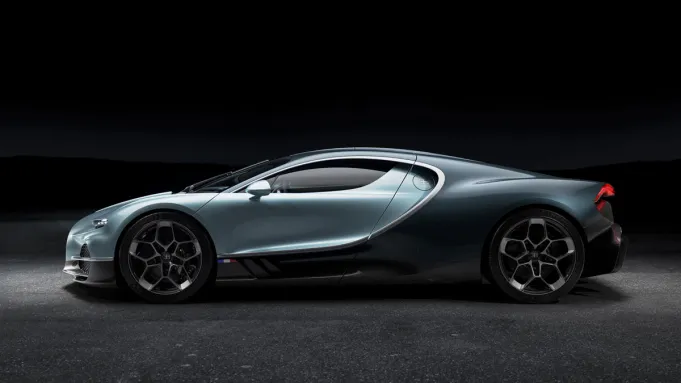
Bugatti Automobiles S.A.S
“Beauty, performance, and luxury formed the blueprint for the Tourbillon. What we have created is a car that is more elegant, more emotive and more luxurious than anything before it,” stated Mate Rimac, Bugatti Rimac’s CEO, to Robb Report during an exclusive preview at the company’s newly opened design studio in Berlin.
He explained that, four years ago, when the Tourbillon concept was on the drawing board, there were multiple suggestions for what an all-new Bugatti might look like. Options included an SUV, a coupe-like crossover and a luxury four-door sedan. Then there was the choice of either a hybrid or all-electric power train. “The proposal to make it electric was the obvious choice. We had our [Rimac] Nevera, that we could easily transfer our technology and re-skin the body. But I felt it was wrong for Bugatti,” said Rimac. “I wanted a successor to the Veyron and Chiron, a true hypercar with a combustion engine. Our customers agreed.”
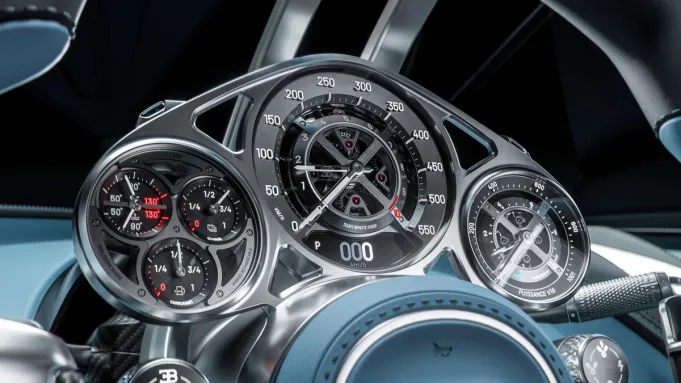
Bugatti Automobiles S.A.S
To create it, Rimac teamed with Cosworth, a renowned British engine builder, to help develop the naturally aspirated V16 mill. Designed to rev to 9,000 rpm, the engine offers a similar output as the original Veyron’s quad-turbocharged W16. To heighten the performance, Rimac and his team used their proven expertise in electric propulsion to pair the V16 with twin electric motors driving the front wheels, with a third at the rear. For battery power, a 25 kWh, oil-cooled 800-volt pack is integrated into the chassis and located behind the passengers. It’s powerful enough to give the Tourbillon a usable electric-only range of around 60 km.
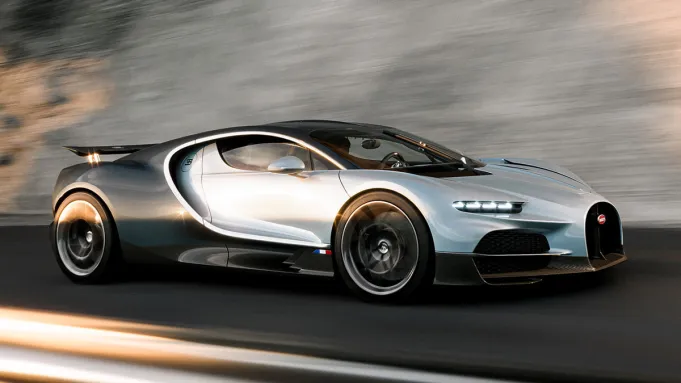
As you would expect, the Tourbillon has been developed to be blisteringly fast. According to Emilio Scervo, Bugatti’s chief technical officer, early prototype tests suggest a rate of acceleration from zero to 100 km/h in 2.0 seconds, zero to 200 km/h in 5.0 seconds, and zero to 300 km/h in 10.0 seconds. Flat out, the max-speed target is 445 km/h, though with a speedometer that reads up to 550 km/h, we expect there’s more to come. “For us, it was important that the car retained the pure and raw analogue feel of a naturally aspirated combustion engine, while pairing it with the agility and ability provided by electric motors,” said Scervo.
The engine itself sits low in the Tourbillon’s new, super-stiff body structure, which is formed using next-generation T800 carbon composites. It features a forged-aluminium, multi-link suspension—front and rear—that replaces the previous double-wishbone steel setup used in the Chiron. The 3-D-printed aluminium suspension arms and uprights, and AI-developed, 3-D-printed hollow airfoil arm at the rear, are nothing less than pieces of art.
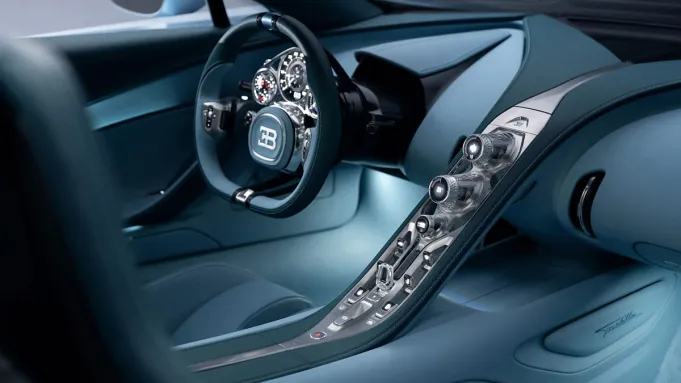
Bugatti Automobiles S.A.S
For the exterior lines, Frank Heyl, Bugatti’s director of design, explained that styling influences came from three landmark Bugattis of old: the Type 35 racer of the 1920s, the long Type 41 Royale built from 1927 through 1933, and the storied Type 57SC Atlantic from the 1930s. “The design focus was on Bugatti’s iconic horseshoe grille. It’s significantly wider and lower than in the Chiron, and it’s from which all lines of the car originate. It defines the car,” said Heyl, who added that another signature element is “the new central windshield wiper, which continues the line that starts on the hood and flows back along the roof. Just like on the Atlantic.” Set back from the grille are twin rows of wafer-thin LED lights. Between them is a narrow panel on the hood that raises up to reveal a “frunk” big enough for a set of custom-designed luggage.
In profile, the sweeping “Bugatti line” around the doors—a defining feature of both the Veyron and Chiron—looks even more striking with the car’s lowered roofline. At the rear, huge exhausts, a Le Mans–style carbon-fibre diffuser (twice the size of that on the Chiron), and a rolling wave of LED lights featuring illuminated “Bugatti” lettering, add to the visual drama. And to allow onlookers to gaze at that V16 power plant—and for cooling purposes—the engine sits open to the elements.
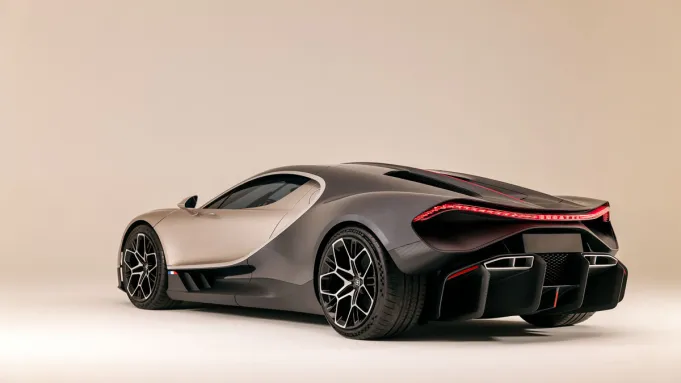
Robb Rice
Upon opening the dihedral “scissor” doors and entering the cockpit, you’re presented with arguably the new Tourbillon’s most dramatic feature; a skeletonised instrument cluster inspired by the art of Swiss watchmaking. Made up of more than 600 components, it’s constructed from titanium with sapphire-glass faces and detailing that incorporates rubies.
The three-dial cluster is fixed in place, with the twin spokes of the flat-bottom steering wheel rotating around it. The unit is constructed, in-house, to remarkable horological tolerances of 50 microns—the average cross-section of a human hair. The entire cluster weighs just 709 g. Cascading down from the middle of the fascia is the centre console featuring crystal glass that’s formed over 13 separate stages to ensure strength and clarity. The aluminium elements are anodised and milled from a single block.
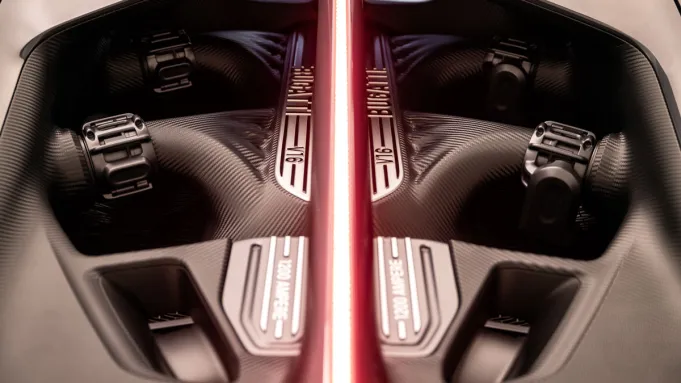
A close-up of the Bugatti Tourbillon’s 1,000 hp, 8.3-liter naturally aspirated V-16 engine.
The Tourbillon’s 1,000 hp, 8.3-liter naturally aspirated V-16 engine is paired with three electric motors.
Robb Rice
To add a little theatre to firing-up that big V16, there’s a prominent center-console aluminium knob that you pull to start, and push to turn off. It’s another nod to Bugatti models of yesteryear. What you won’t see, however, are any touchscreens. Heyl believes that the primary element that dates a car is an oversized screen. “What was state-of-the-art 10 years ago, is now ugly,” said Heyl. “The Tourbillon is designed to be timeless.”
In Bugatti tradition, the Tourbillon will also be highly exclusive. Only 250 examples are planned, each starting at around $6.3 million. The first customer cars are scheduled to be built at Bugatti’s atelier in Molsheim, France, starting in 2026.
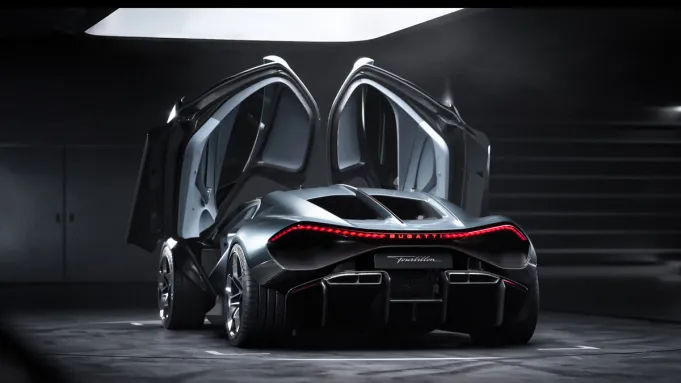
Bugatti Automobiles S.A.S
“Yes, it is crazy to build a new V16 engine, to integrate it with a new battery pack and electric motors, and to have 3-D-printed suspension parts and a real Swiss watchmaker instrument cluster,” noted Rimac. “But it is what Ettore Bugatti would have done.”
You may also like.
For Dubai, the Time Is Now
The bustling Middle Eastern city is emerging as an important hub for serious watch collectors
Tucked away in a corner of the Dubai International Financial Centre, near the Ritz-Carlton, is Perpétuel Gallery, an unassuming 1,200 m² boutique displaying some of the world’s most important independent watchmaking. During Dubai Watch Week—a biannual event run by the Seddiqi family, the most prominent watch retailers in the UAE—the shop, just a few minutes’ walk from the fair in the DIFC, held its own exhibition that was filled to the brim with the watchmakers themselves, from Roger W. Smith to Simon Brette to Rémi Maillat of Krayon. There, holding court, was Hamdan Bin Humaid Al Hudaidi, a distinguished collector who founded Perpétuel in 2021, in the middle of the Covid pandemic.
“I never thought I would take my passion professionally, ever,” he tells Robb Report. “Everyone was against the idea because they were very certain this would fail.” How wrong they were. Instead, Perpétuel has become one of the most significant global players in connecting and brokering deals between collectors and their indie idols. As a serious client himself, Al Hudaidi has unique relationships that allow him to create limited editions exclusive to the gallery—quite a feat when you consider the waiting lists for some of the watchmakers in question are a decade or more long. A recent collaboration of 15 limited-edition Krayon Anywhere watches with desert-orange accents sold out to clients—not just in the Middle East, but also in Australia, the US and South Africa.

Courtesy of Perpétuel Gallery
It’s proof positive of the area’s booming and influential watch scene. Many credit Dubai Watch Week—and by extension the Seddiqi family—for the fervent local interest in watch collecting. When the event launched in 2015, it was small, hosting just 15 brands, mostly independents. “It was really a project to give back to the industry,” says Hind Abdul Hamied Seddiqi, director general of the event and CMO and communications officer for Ahmed Seddiqi & Sons, “but also to educate the general public that the watch industry is not as intimidating as you think.” It’s a strategy that has paid off. Last year’s edition ballooned to 60 brands, including big-name players such as Rolex, Audemars Piguet and Van Cleef & Arpels, along with nearly 24,000 attendees, the largest crowd to date.
Despite the draw, the five-day-long public event has an easygoing appeal that other watch fairs often lack. One can spot Philippe Dufour perched outside a pavilion smoking a pipe, Kari Voutilainen enjoying an alfresco lunch, or Rexhep Rexhepi in line for an espresso. It’s an exceedingly rare chance for collectors to mingle with the masters in a relaxed space where everyone is in a jovial mood thanks to the casual atmosphere and balmy weather—and Seddiqi plans to keep it that way. “I worry if we go bigger, we’ll lose this feeling of intimacy,” she says. “I have a lot of people asking me to commercialise the show, but it’s just going to ruin the whole vibe.”
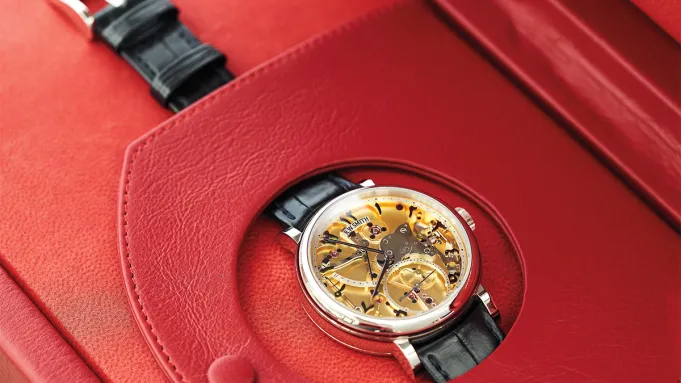
Courtesy of Perpétuel Gallery
The explosion of interest isn’t just for new timepieces: vintage is also having its moment. Historically, the Middle East hasn’t been receptive to “used” goods, but recent years have reflected a shift in perspective. Tariq Malik, cofounder and managing partner of Momentum, also located in the DIFC, just a three-minute walk from Perpétuel, was an early pioneer in the area when he opened shop in 2011. In the beginning, he says, it would be common for someone to look at his wares and ask if he was selling “used” watches. “I said, ‘It’s vintage,’ and they said, ‘Oh, wow.’ When I would say ‘vintage’ they would start pulling out their camera and taking photos. We brought vintage to Dubai, so it was a new thing.” He’s now sought-after by clients both in the UAE and internationally for his allotment of rare Rolexes, with a specialisation in Day-Dates and hard-to-find Stella and stone dials.
Al Hudaidi also dabbles in vintage, predominantly ultra-rare Pateks—one might walk into Perpétuel and find him casually pulling a full-set Ref. 2499 third series from a coffee-table drawer. Naturally, that watch has sold along with two other full-set 2499s, but a unique Patek Philippe Ref. 1491J chronograph from the ’40s is still up for grabs (at press time, anyway). It was made by the Stern family for Jimmy Powers, an American boxing commentator during the era.
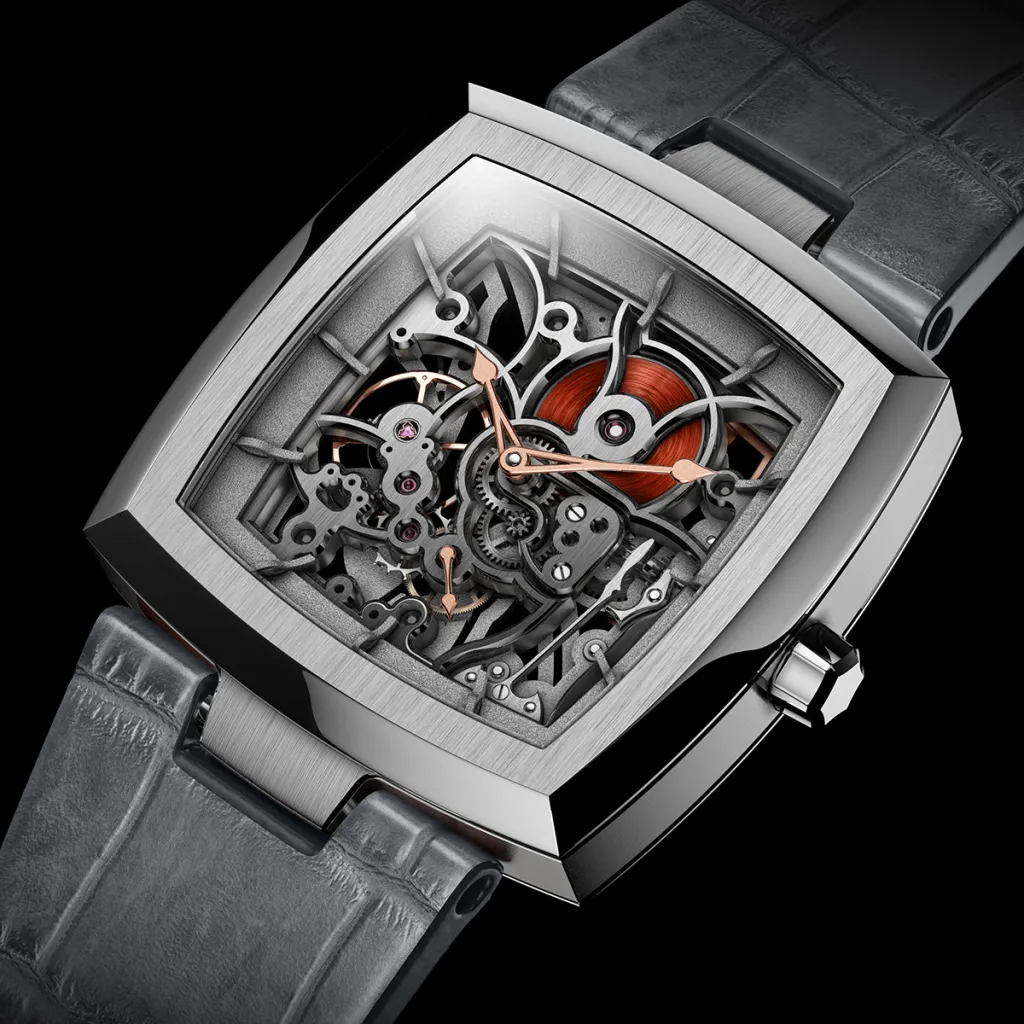
“I got goosebumps when I heard his voice on YouTube,” says Al Hudaidi. “I was like, ‘Oh, my God—that timepiece was his. And his name is engraved on the back!”
You may also like.
6 Ways Technology Will Transform Your Private-Jet Experience in the Next Decade
Extreme leisure or full-throttle engagement? The private-jet cabin of the future will offer both.
Within a decade, private-jet cabins could make even today’s cutting-edge interiors seem ancient by comparison. From digital skylights and smart seats to eye-tracking functionality and immersive soundscapes, the array of innovative amenities could transform even the longest flights into time well spent. Here, six areas in which technology will take the onboard experience to new heights.
Screen Time
Within three to five years, some private jets may have select windows replaced with curved, high-definition 4K OLED displays connected to live video feeds from the aircraft’s exterior. Imagine a cabin ceiling that morphs into a conservatory with a spectacular view of the moon, or full-height windows that present the landscape below with incredible fidelity. Information overlays are easy additions, but consider that these built-in visual portals could also double as insane gaming screens.
Seat Change
E-textiles will transform the next generation of jet seats into intuitive in-flight spa recliners. Sensors within the fabric will note your size, weight, pressure distribution, and body temperature, then rely on their A.I.-driven processors to, say, heat the seat before you realise you’re chilly or massage that kink in your back without being asked. Powering themselves by converting body heat into electricity, the chairs might also know to widen and recline when you nod off.
Seeing the Light
Chronobiological lighting to mitigate jet lag will comprise organic light-emitting diode (OLED) panels, capable of creating 16.3 million different light combinations, to reset a passenger’s internal clock as they traverse time zones. Eventually, such panels will migrate from light fixtures to smart fabric on the ceiling, resulting in more diffuse illumination that allows for near-infinite options across the colour spectrum.
And there are many other applications. For example, OLED displays, as wide as a piece of paper, can be used to digitally transform the entire wall of the cabin’s colour, texture or scene. It is called projection mapping, and it will make changing the wall color from hot pink to a textured crocodile leather as easy as changing your computer screen saver. As Ingo Wuggetzer, vice president of cabin marketing for Airbus, explains, light literally creates spaces, giving cabin designers a highly versatile and easily customisable digital canvas.
Higher Management
The ability to access basic audio or video from your smartphone is here, but imagine faster, streamlined connectivity that lets you manage video conferencing, heating, mood lighting, window shades, service requests, even a steriliser—from a single app. According to Airbus’s Wuggetzer, next-gen digital architecture will turn personal spaces into individual “ecosystems” controlled by each passenger. Tim O’Hara, director of completions research and development at Gulfstream, notes that eye-tracking technology could allow you to interact with the app via virtual screen, meaning you don’t even have to lift a finger.
Breaking the Sound Barrier
Rosen Aviation has developed a new onboard audio system with Laurence Dickie, designer of the famed Bowers & Wilkins Nautilus loudspeaker. According to Rosen’s Lee Clark, the goal is to go from today’s audio equivalent of “a 1970s eight-track” to what he refers to as “Elvis, six feet away, singing to you”—a soundscape that only you will hear, delivered by headrest speakers and haptic drivers in the seat. Meanwhile, Bongiovi Aviation intends to employ transducers embedded in the jet’s interior side panels, eliminating the need for traditional speakers altogether. The advantages are numerous, and it allows airframers to reduce cabin weight and fully utilise space while eliminating traditional speakers from the design.
Bringing movie-theater audio quality to aviation is already available. Dolby Atmos puts you inside the movie or song as it is playing. In collaboration with Dolby, SkyCinema Aviation was the first to create an Atmos-enabled processor built for business jets to compensate for cabin altitude and jet noise. The result? You will clearly hear the car approaching from a half mile away in that famous scene of the 1959 Hitchcock classic North by Northwest, just as the director intended.
Hands Free
With full showers, skylights, and large vanities gracing the lavatories of the most luxe business jets today, what could be next? The smart lavatory is evolving into a nearly completely hands-free space by incorporating sensors to activate everything from faucets to showers. Using an AI algorithm, Diehl Aviation has taken it a step farther to add more functionality with voice-controlled commands for opening and closing the door, turning on lights, and activating water. Hologram light switches will eventually keep the lavatory completely hands free, while smart mirrors can multitask by providing an interactive display of digital content.






